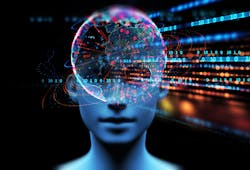This article originally appeared in the November 2022 issue of Security Business magazine. When sharing, don’t forget to mention Security Business magazine on LinkedIn and @SecBusinessMag on Twitter.
Artificial intelligence (AI) has come a long way very quickly – so quickly, in fact, that the public perception of AI remains heavily influenced by its portrayal on television or in movies, even as its real-life capabilities have begun to match and even exceed many of those depictions.
Never fear, a rogue AI is not going to form Skynet or create an army of Austrian-accented Terminators, nor does it mean you are likely to be having a conversation with an AI companion anytime soon.
That said, it does mean that working with artificial intelligence technology is no longer the exclusive practice it once was. Today, different forms of AI are being used in a wide range of devices and for a variety of different business and consumer applications.
For the security industry, this is wonderful news. Today’s security devices, like internet protocol (IP) camera and audio solutions, are increasingly capable of leveraging AI technology natively, at the network edge. This means that more powerful analytics can be run on the devices themselves, keeping bandwidth and data storage needs in check.
This means that not only are more developers capable of creating AI-based solutions, but those solutions are becoming available – and valuable – for an increasing number of consumers as well. This growing democratization of AI technology is enabling valuable new applications, both within the security industry and beyond.
Where AI Stands, and How It Got Here
Artificial intelligence is a scientific term with a scientific definition: it applies to digital systems capable of performing tasks that normally require human intelligence. If that sounds like a broad definition, that’s because it is – AI is essentially an umbrella term that encompasses everything from chatbots to self-driving vehicles. But under that umbrella, there are other, more specific terms: machine learning and deep learning.
Machine learning (ML) is more complex, and it applies to technology that shows signs of basic cognition, or the ability to learn. Deep learning (DL) adds even more complexity, helping machines perform tasks like pattern recognition and information classification. Based on that definition, it should come as little surprise that the advent of deep learning – and the deep learning processing units (DLPUs) that power today’s advanced cameras – has been a boon for the security industry.
It is impossible to overstate how critical these DLPUs have been for the democratization of AI. It is important to note that video analytics are not a “new” technology – they have been around for many years – but they tended to suffer from both poor accuracy and a generally cumbersome and expensive user experience. Movement detection was possible, but prone to false alarms. Object detection was possible, but not always accurate.
As the image quality of cameras improved over time, some of these issues were lessened, but the higher quality the image, the greater the need for pricey storage space, either on premises or in the cloud. And while powerful DLPUs have been available in larger servers for some time, granting the ability to run analytics in the cloud, both the servers themselves and the bandwidth needed to transmit high quality images or entire video clips could be extremely expensive. As a result, early AI-based analytics were limited in both their scope and their use.
Now, thanks to DLPUs, these AI-based analytics can be run on the cameras themselves, analyzing and classifying data so that only the relevant metadata needs to be sent to the cloud. This vastly reduces the amount of both bandwidth and storage needed to use advanced new analytics while also decreasing the on-site hardware footprint, making the technology much more accessible to a broader range of potential customers.
On top of that, the platforms on edge devices have become much more capable and easier to develop for. This is inspired more and more developers to create new analytics, resulting in expanding use cases that go far beyond traditional security applications. This explosion of interest in AI-based analytics has expanded the security market in fascinating new ways.
Expanding into New Areas
Analytics, both video and audio, have traditionally been very security focused – detecting trespassing, theft, assault, and other potential crimes was paramount. Analytics could help: if someone crosses a certain line or enters an area at night, the security team needs to know. If someone is behaving aggressively or the sound of breaking glass is heard, the security team probably needs to know that, too. Rather than watching recorded video to look for evidence, security teams can now launch an immediate response the moment suspicious or alarming behavior is detected. In many cases, this can prevent situations from escalating, allowing security to be proactive rather than reactive.
Those applications will always be valuable. But as a wider range of companies enter the analytics space – both on the developer side and the customer side – a growing number of them are exploring other applications. Many are looking at their camera deployments and wondering whether they can add additional functionality to increase the value of their hardware investment.
Manufacturing companies, for instance, are not just interested in keeping trespassers out of their facilities, they are also interested in analytics that can monitor assembly lines and identify potential opportunities for improvement. Are employees following the proper procedures? Are things moving too fast, or too slow? Are there opportunities to improve the workflow process on the factory floor?
In the past, those questions could only be answered using an extremely high-end machine vision camera – one that might cost tens of thousands of dollars per device.
Today, that same functionality can be achieved using the same DLPU-equipped cameras that many organizations may already have installed as part of their security setup – and a growing number of them are realizing that they have capabilities they have not been using.
New Developers, New Possibilities
Because of this, and platforms that are very easy and effective to develop AI code for, developers of all types have jumped at the chance to create new applications for broader use-cases. And it isn’t just a case of security analytics developers expanding into other areas – a wave of new developers has entered the fray. In fact, the need for powerful new analytics has even inspired developers with complementary skills to work together.
People counting technology is valuable from a security perspective, but it can be combined with other analytics to grant businesses new insights. A hardware store might be interested in knowing how many customers walk through its doors on a daily basis so they can better plan around the peaks and valleys of foot traffic. But chances are their own employees are also coming and going frequently – how can they avoid counting them? Is there another data set to cross reference, such as shirt color?
That might not matter from a security perspective, but today’s developers have become good at understanding the relationship between discrete data sets and using them to identify and solve new problems. That same store might want to know how foot traffic is impacted by weather, season, sales promotions, or point of sale data. It might be important to know that on Saturdays during the summer, there tends to be a 40% uptick in customers between 11 a.m. and 1 p.m., so a similar 40% uptick in staff is needed.
This has nothing to do with safety and security – it simply serves to make the customer experience better by avoiding big lines, long wait times, and unavailable staff members. It makes the entire process more seamless, and the customer has no idea it is made possible by AI-based technology built off security and surveillance software.
It is also interesting to note that the benefits of this democratization actually do circle back around to improve security, as well. For example, a company that makes long-distance detection and tracking software might have quite a bit to offer a company that focuses on license plate recognition. A camera mounted on the side of a building might have a limited vantage point, only able to read license plates on cars that drive up to the entrance. But with the help of long-distance tracking analytics, that same technology might be deployed on a rooftop camera able to see read the plates on vehicles at the edge of the facility or far into the parking lot.
That same technology could also be applied to gun detection instead of license plate recognition, enabling security systems to identify an armed assailant further from the building, granting them extra time that can potentially save lives.
Without new developers delivering analytics with greatly expanded capabilities and use cases, none of this would be possible. And without deep learning technology becoming more readily available, fewer consumers would be able to take advantage.
Democratization of Data
It is important to avoid the hype train. Because of AI’s promise, there is a tendency to assume that the technology can solve any problem, or that it will sweep through the security industry overnight and allow end-users to do whatever they want. That is not exactly the case. It will take time and incremental improvement before AI, ML, and DL technologies reach full maturity, and both integrators and consumers should be wary of manufacturers and developers who overpromise.
That said, the democratization of AI isn’t the only thing having an impact. The democratization of data is helping, too.
AI-based technology requires vast amounts of training data to improve its accuracy, and countless organizations have been gathering data for years and years, whether they are actively using it or not. A company might have 10 or 15 years of license plate data gathering dust on a server somewhere, unused. This is an invaluable resource when it comes to training modern license plate recognition analytics, and that company might be willing to share that data with partners looking to improve the accuracy of their own analytics. Even going from 85% accuracy to 95% accuracy is huge. That might not seem like a significant jump, but it can eliminate a considerable number of false alarms, which in turn can allow security teams to investigate each actual incident more thoroughly.
Thirty alarms in a day are a lot, but reducing that to 10 might enable staff to respond to each one more thoroughly. AI is not a magic wand, but the incremental improvements it enables make a real difference.
Don’t underestimate the importance of the democratization of data when it comes to making AI more valuable and desirable. It is neither desirable nor feasible for every company to master every AI application, which encourages companies to partner with others who have a different type of expertise.
Sharing data between them is a win for everyone, and it improves the quality of AI solutions across the board. As in the long-distance tracking example, different companies with different specialties can come together to create something better. This helps customers see the value of AI grow over time, encouraging further adoption and, in turn, further development.
Democratization Inspires Innovation
Because many modern cameras come equipped with the deep learning capabilities needed to run advanced new analytics – along with platforms that are easy to develop code for – AI-based technologies have reached a vast array of new customers.
As the applications for surveillance devices expand beyond traditional security capabilities and into business intelligence and operations, interest in the technology has expanded both on the developer side and the consumer side, creating a feedback loop of positive reinforcement: as developers create exciting new applications, customers become more interested, and as customer become more interested, developers are spurred to further innovation.
As AI becomes further democratized, expect to see that innovation continue – or even accelerate.





